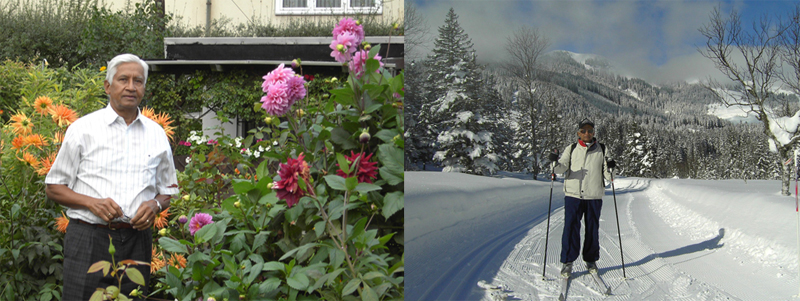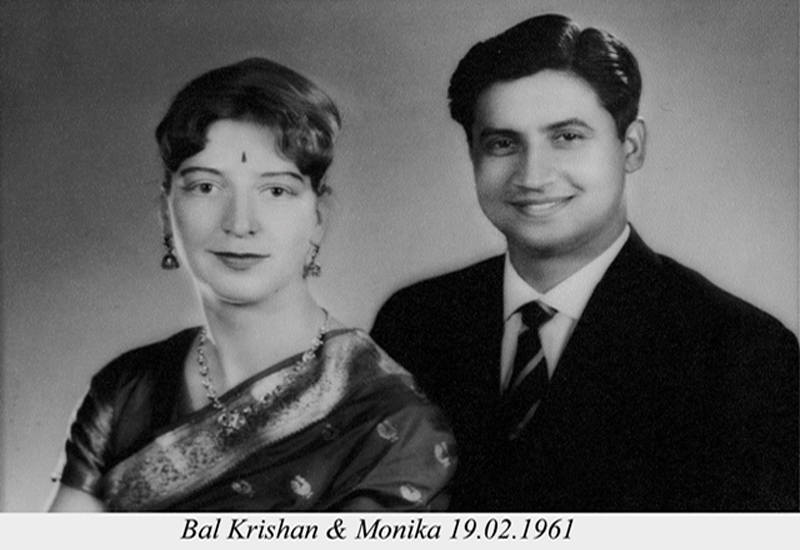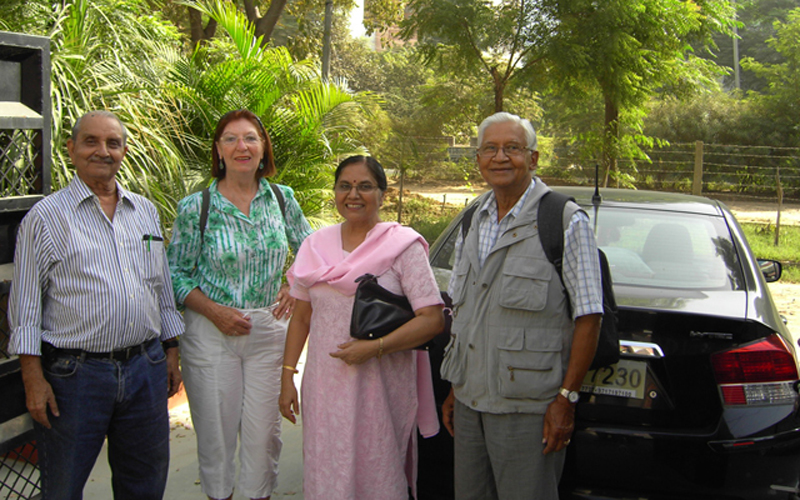Agencies
TORONTO: Currently, there are estimated to be over 200,000 IITians who are settled abroad.
And Germany-based Bal Krishan Kaplish could be the grand-dad of the IITian diaspora as he was probably the first IITian to move out of India in 1955 - the year in which the first batch from IIT Kharagpur passed out.
``I was the first of our batch who left India for further studies. I joined Sheffield University in October 1955,’’ he says in an interview from Duisburg in Germany where he lives with his German wife Monika as seen in the above picture.
Indeed, he could also be the first IITian to marry a foreigner when he tied the knot with Monika in 1961. ``At that time it was a sensation to marry’’ a foreigner, he laughs.
As the IIT Kharagpur - or the entire IIT system - celebrates its diamond jubilee this year, Kaplish goes nostalgic about the good old times at independent India’s first IIT.
``I had done my I.Sc. from Government College, Rohtak, in 1951, and was waiting for the results at Jamshedpur with my parents when an advertisement for admission to IIT Kharagpur appeared in newspapers. I applied for this high grade institute,’’ he recalls.
He says his interview was held in Calcutta. ``I was very lucky to be selected for mechanical engineering. At that time in 1951, we didn’t know that this Institute was going to become that great. But it had all the hallmarks of a great Institute as all the students admitted were the cream of India. There were many toppers from various universities,’’ he recollects.
[caption id="attachment_79551" align="alignnone" width="800"] IITian Bal Krishan Kaplish in his garden at Duisburg (Germany) and skiing in Austria.[/caption]
Kaplish says their first session was delayed by about a month as the mess of Patel Hall was not fully ready.
``Further, there was no connecting road from Patel Hall to the ring road connecting the Hijli Jail Building. It was only mud and water. All the future students were informed by post. But about 20 students did not get the information on time, including me. Our rooms were ready but for food a mess was arranged in an old building near Patel Hall,’’ he says.
He is amused to remember the erratic water supply on the upper floors of Patel Hall. ``Very often, we had to run to the lower floors with our head and body full of shampoo and soap,’’ he laughs.
Asked about his memories of Nehru visiting the IIT, he says, ``Nehru came to lay down the foundation stone of the new building. It was Sunday morning when the prime minister expressed his desire to meet some students, before leaving for Kalaikunda Airport. Some 10-15 students, who were early risers, rushed to the Guest House where Nehru was staying. I was one of them to meet him. To our surprise, Sheikh Abdullah, the Chief Minister of Jammu & Kashmir, had also come with Nehru. The prime minister shook hands with all of us. It was a very short meeting as he immediately left for the airport. I found him very sympathetic.’’
He recalls R.S Gupta of electrical engineering as his best friend at the IIT. ``In our free time, we were always together. We still have very close contact with each other,’’ says Kaplish, adding that the good times passed quickly.
[caption id="attachment_79553" align="alignnone" width="800"]
IITian Bal Krishan Kaplish in his garden at Duisburg (Germany) and skiing in Austria.[/caption]
Kaplish says their first session was delayed by about a month as the mess of Patel Hall was not fully ready.
``Further, there was no connecting road from Patel Hall to the ring road connecting the Hijli Jail Building. It was only mud and water. All the future students were informed by post. But about 20 students did not get the information on time, including me. Our rooms were ready but for food a mess was arranged in an old building near Patel Hall,’’ he says.
He is amused to remember the erratic water supply on the upper floors of Patel Hall. ``Very often, we had to run to the lower floors with our head and body full of shampoo and soap,’’ he laughs.
Asked about his memories of Nehru visiting the IIT, he says, ``Nehru came to lay down the foundation stone of the new building. It was Sunday morning when the prime minister expressed his desire to meet some students, before leaving for Kalaikunda Airport. Some 10-15 students, who were early risers, rushed to the Guest House where Nehru was staying. I was one of them to meet him. To our surprise, Sheikh Abdullah, the Chief Minister of Jammu & Kashmir, had also come with Nehru. The prime minister shook hands with all of us. It was a very short meeting as he immediately left for the airport. I found him very sympathetic.’’
He recalls R.S Gupta of electrical engineering as his best friend at the IIT. ``In our free time, we were always together. We still have very close contact with each other,’’ says Kaplish, adding that the good times passed quickly.
[caption id="attachment_79553" align="alignnone" width="800"] 1961 - when he became the first IITian to marry a foreigner who was his girlfriend from Germany. Monika came to Jamshedpur to get married as per Hindu rituals.[/caption]
And in 1955, after completing his course, when young Kaplish came back to Jamshedpur to consult his father - who was with the Indian Steel and Wire Products Limited (I.S.W.P. Ltd) in a senior position since its inception in 1928 - for his job prospects, two offers were already waiting for him.
``One offer was from TELCO (Tata Engineering & Locomotive Company) in Jamshedpur and the second from the Chittranjan Locomotive factory. The director of the company where my dad worked knew me also very well because I had done some training during summer vacation. So he asked my father to bring me next morning to his office. Without much conversation, I was put under the Chief Engineer,’’ he says of his first job.
Then he adds excitedly, ``But after two months, the director called me to his office and asked if I was interested in further studies. I said: `Yes, if somebody will support me’. He told me that he was sending me to Sheffield University to study metallurgy. I should get my passport made and further steps would be taken to get my admission for a post-graduate course in metallurgy!’’
The young engineer could not believe the turn his luck had taken.
``So, on October 2, 1955, I landed in London and proceeded to Sheffield. It was a great time in my life as I completed my M. Met. in 1957. My research work was published in Journal of the British Foundry Man,’’ he gushes.
With the M.Met. degree under his belt, young Kaplish joined some wire mills and wire rod mills to undergo a year of practical training.
``And next year in June 1958 I proceeded to Germany for training in foundry and roll foundry. I had to learn German from the very beginning. It was quite hard but I managed it well.’’
[caption id="attachment_79556" align="alignnone" width="800"]
1961 - when he became the first IITian to marry a foreigner who was his girlfriend from Germany. Monika came to Jamshedpur to get married as per Hindu rituals.[/caption]
And in 1955, after completing his course, when young Kaplish came back to Jamshedpur to consult his father - who was with the Indian Steel and Wire Products Limited (I.S.W.P. Ltd) in a senior position since its inception in 1928 - for his job prospects, two offers were already waiting for him.
``One offer was from TELCO (Tata Engineering & Locomotive Company) in Jamshedpur and the second from the Chittranjan Locomotive factory. The director of the company where my dad worked knew me also very well because I had done some training during summer vacation. So he asked my father to bring me next morning to his office. Without much conversation, I was put under the Chief Engineer,’’ he says of his first job.
Then he adds excitedly, ``But after two months, the director called me to his office and asked if I was interested in further studies. I said: `Yes, if somebody will support me’. He told me that he was sending me to Sheffield University to study metallurgy. I should get my passport made and further steps would be taken to get my admission for a post-graduate course in metallurgy!’’
The young engineer could not believe the turn his luck had taken.
``So, on October 2, 1955, I landed in London and proceeded to Sheffield. It was a great time in my life as I completed my M. Met. in 1957. My research work was published in Journal of the British Foundry Man,’’ he gushes.
With the M.Met. degree under his belt, young Kaplish joined some wire mills and wire rod mills to undergo a year of practical training.
``And next year in June 1958 I proceeded to Germany for training in foundry and roll foundry. I had to learn German from the very beginning. It was quite hard but I managed it well.’’
[caption id="attachment_79556" align="alignnone" width="800"] Bal Krishan Kaplish and wife Monika seen with their friends in Palam Vihar, Gurgaon, in September 2012.[/caption]
He says his training in Germany lasted one year and nine months and was financed by the director of I.S.W.P. Ltd.
Then India beckoned. And on his return, he joined I.S.W.P. Ltd in April 1960.
``I was put directly under the head of the Wire Rod Mill department. A German was the head of the department and he had three more Germans as assistants. A new modern Wire Rod Mill of Schloemann of Germany was to be installed and I was given the charge of commissioning this new mill,’’ he remembers.
Then the busy young engineer took time off to marry a German girl named Monika whom he had met during his stay in Germany.
``At that time it was a sensation to marry a foreigner. I tied the knot with Monika as per Hindu rites. Our wedding was held in Jamshedpur,’’ Kaplish says.
Life was hunky-dory for the couple as two daughters were born to them. Kaplish was made head of the Wire Rod Mill department in 1963.
``At that time, I also used to deliver lectures to the graduate students of RIT, and the Staff training Institute of TISCO, Jamshedpur. I was also the examiner for Ranchi University.’’
In 1971, his life took yet another turn when Schloemann-Siemag in Dusseldorf offered him a slot and he left for his wife’s country.
``After working there for 25 years, I retired and settled in Duisburg in Germany. Both our daughters are also settled in Germany. There are not many IITians in Germany, but I am the oldest of the lot,’’ says Kaplish, adding that he visited India a few times officially for advising TISCO and I.S.W.P.Ltd.
But the big moment, he says, came in October 2001 when he was invited by his alma mater IIT Kharagpur to attend its golden jubilee celebrations.
``My wife and I both went there. The students had made some good programmes and organized gala dinners. I was sorry to see that nobody from my batch was present. It was told to me that a celebration was also held in summer 2001 in Calcutta. Cultural programmes were presented by different Halls of residence. I found that there was a lot of rivalry between the Halls and they were disturbing the programmes of the other Hall. I brought this to the notice of Prof. Bhattacharia, who was the organiser of the function. The students of IIT should be proud of their alma mater and have harmony with each other.’’
Kaplish says a few of his old IIT class-mates have visited and stayed with him in Germany. ``I would like to make particular mention of talented R.S. Bir, M.A .Parameswaran, Balbir Singh and B.C. Mondal,’’ he says, adding that he is proud of his IIT fraternity.
Bal Krishan Kaplish and wife Monika seen with their friends in Palam Vihar, Gurgaon, in September 2012.[/caption]
He says his training in Germany lasted one year and nine months and was financed by the director of I.S.W.P. Ltd.
Then India beckoned. And on his return, he joined I.S.W.P. Ltd in April 1960.
``I was put directly under the head of the Wire Rod Mill department. A German was the head of the department and he had three more Germans as assistants. A new modern Wire Rod Mill of Schloemann of Germany was to be installed and I was given the charge of commissioning this new mill,’’ he remembers.
Then the busy young engineer took time off to marry a German girl named Monika whom he had met during his stay in Germany.
``At that time it was a sensation to marry a foreigner. I tied the knot with Monika as per Hindu rites. Our wedding was held in Jamshedpur,’’ Kaplish says.
Life was hunky-dory for the couple as two daughters were born to them. Kaplish was made head of the Wire Rod Mill department in 1963.
``At that time, I also used to deliver lectures to the graduate students of RIT, and the Staff training Institute of TISCO, Jamshedpur. I was also the examiner for Ranchi University.’’
In 1971, his life took yet another turn when Schloemann-Siemag in Dusseldorf offered him a slot and he left for his wife’s country.
``After working there for 25 years, I retired and settled in Duisburg in Germany. Both our daughters are also settled in Germany. There are not many IITians in Germany, but I am the oldest of the lot,’’ says Kaplish, adding that he visited India a few times officially for advising TISCO and I.S.W.P.Ltd.
But the big moment, he says, came in October 2001 when he was invited by his alma mater IIT Kharagpur to attend its golden jubilee celebrations.
``My wife and I both went there. The students had made some good programmes and organized gala dinners. I was sorry to see that nobody from my batch was present. It was told to me that a celebration was also held in summer 2001 in Calcutta. Cultural programmes were presented by different Halls of residence. I found that there was a lot of rivalry between the Halls and they were disturbing the programmes of the other Hall. I brought this to the notice of Prof. Bhattacharia, who was the organiser of the function. The students of IIT should be proud of their alma mater and have harmony with each other.’’
Kaplish says a few of his old IIT class-mates have visited and stayed with him in Germany. ``I would like to make particular mention of talented R.S. Bir, M.A .Parameswaran, Balbir Singh and B.C. Mondal,’’ he says, adding that he is proud of his IIT fraternity.